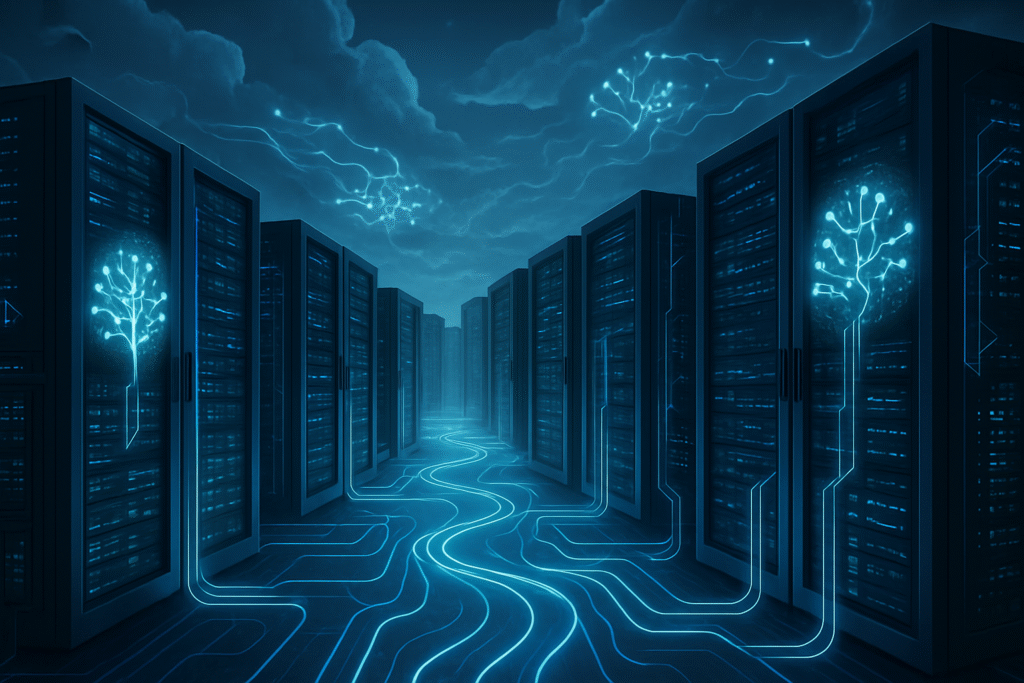
Redwood Shores, CA – October 16, 2025 – Oracle Corporation (NYSE: ORCL) has sent shockwaves through the technology world with its audacious projection of reaching $166 billion in Oracle Cloud Infrastructure (OCI) revenue by fiscal year 2030. This ambitious target, announced today, comes on the heels of a monumental $300 billion AI cloud computing and data center agreement with OpenAI, reported in late September 2025. The unprecedented deal, one of the largest technology infrastructure partnerships ever disclosed, is set to dramatically reshape the competitive landscape of the cloud and artificial intelligence sectors, solidifying Oracle's position as a critical enabler of the AI revolution.
The sheer scale of these announcements underscores a pivotal moment for Oracle, transforming its market perception from a legacy enterprise software provider to a dominant force in high-performance AI infrastructure. The $300 billion, five-year contract with OpenAI, slated to commence in 2027, is a testament to the insatiable demand for computational power required by next-generation generative AI models. This strategic move has already ignited a significant surge in Oracle's valuation, briefly elevating its Chairman, Larry Ellison, to the status of the world's richest person, and signaling a new era of growth driven by the burgeoning AI economy.
The Dawn of Gigawatt-Scale AI Infrastructure
The core of Oracle's recent triumph lies in its ability to provide specialized, high-performance cloud infrastructure tailored for intensive AI workloads. The $300 billion OpenAI agreement is not merely a financial transaction; it's a commitment to deliver approximately 4.5 gigawatts of computing capacity, a figure comparable to the electricity output of multiple Hoover Dams. This colossal infrastructure will be instrumental in powering OpenAI's most advanced generative AI models, addressing the critical bottleneck of compute availability that has become a defining challenge for AI innovators.
Central to this partnership is Oracle's support for "Project Stargate," OpenAI's ambitious initiative to build a next-generation AI supercomputing facility designed for gigawatt-scale energy consumption. Oracle's competitive pricing for powerful GPU infrastructure, combined with its burgeoning global data center footprint, proved to be a decisive factor in securing this landmark deal. This approach differentiates Oracle from traditional hyperscalers like Amazon Web Services (AWS) (NASDAQ: AMZN), Microsoft Azure (NASDAQ: MSFT), and Google Cloud (NASDAQ: GOOGL), by offering a dedicated and highly optimized environment for AI training and inference at an unparalleled scale. While other cloud providers offer robust AI services, Oracle's recent focus on securing massive, dedicated AI compute contracts marks a significant strategic pivot, emphasizing raw power and scale over a broader, generalized cloud offering. Initial reactions from the AI research community highlight the necessity of such colossal infrastructure to push the boundaries of AI, with many experts noting that the future of advanced AI hinges on the availability of such specialized compute resources.
Reshaping the AI Competitive Landscape
This monumental deal and Oracle's aggressive revenue projections carry profound implications for AI companies, tech giants, and startups alike. Oracle itself stands to be the primary beneficiary, cementing its role as a critical infrastructure backbone for the most demanding AI workloads. The deal provides OpenAI with guaranteed access to the vast computational resources it needs to maintain its leadership in generative AI development, allowing it to focus on model innovation rather than infrastructure procurement.
For other major cloud providers—Amazon (NASDAQ: AMZN), Microsoft (NASDAQ: MSFT), and Google (NASDAQ: GOOGL)—the Oracle-OpenAI partnership presents a formidable competitive challenge. While Microsoft already has a deep partnership with OpenAI, Oracle's ability to secure such a massive, dedicated infrastructure contract demonstrates its growing prowess in the high-stakes AI cloud race. This could force other hyperscalers to re-evaluate their own AI infrastructure strategies, potentially leading to increased investments in specialized GPU clusters and more aggressive pricing to attract AI-centric clients. Startups and smaller AI labs might also look to OCI for access to powerful compute, especially if Oracle continues to offer competitive pricing and dedicated resources. The deal underscores the increasing capital intensity of AI development, where access to vast, affordable compute is becoming a significant barrier to entry and a key determinant of competitive advantage.
The Broader Implications for the AI Era
Oracle's strategic maneuvers fit squarely into the broader narrative of the AI landscape: the relentless pursuit of computational power. As AI models grow exponentially in size and complexity, the demand for underlying infrastructure has skyrocketed, creating an "AI compute crunch." This deal highlights that the future of AI innovation is not just about algorithms but also about the physical infrastructure that supports them. It signals a new phase where access to gigawatt-scale computing will differentiate the leaders from the laggards.
The impacts extend beyond mere computing power. The massive energy requirements for such data centers raise significant environmental concerns, prompting discussions around sustainable AI and the development of energy-efficient hardware and cooling solutions. While the immediate focus is on performance, the long-term sustainability of such infrastructure will become a critical talking point. Comparisons to previous AI milestones, such as the rise of specialized AI chips or the development of massive training datasets, show that infrastructure has always been a quiet but foundational driver of progress. This Oracle-OpenAI deal elevates infrastructure to a front-and-center role, akin to the early days of the internet when network backbone capacity was paramount. However, concerns about the profitability of these massive AI infrastructure deals have also emerged, with reports indicating lower gross margins on Nvidia chip rental revenue for Oracle compared to its overall business. This suggests a delicate balance between aggressive growth and sustainable financial returns.
Charting the Future of AI Infrastructure
Looking ahead, the Oracle-OpenAI deal and Oracle's ambitious OCI projections portend several key developments. In the near term, we can expect Oracle to significantly accelerate its data center expansion efforts, with capital expenditure expected to exceed $25 billion annually to build out the revenue-generating equipment needed to support these massive contracts. This expansion will likely include further investments in advanced cooling technologies and renewable energy sources to mitigate the environmental impact of gigawatt-scale computing.
Longer term, this partnership could catalyze a trend of more strategic, multi-billion-dollar infrastructure deals between cloud providers and leading AI labs, as the demand for specialized AI compute continues unabated. The challenges that need to be addressed include maintaining profitability amidst high hardware costs (especially Nvidia GPUs), ensuring energy efficiency, and developing new management tools for such colossal, distributed AI workloads. Experts predict that the race for AI compute will intensify, pushing the boundaries of data center design and prompting innovations in chip architecture, networking, and software orchestration. The success of "Project Stargate" will also be closely watched as a blueprint for future AI supercomputing facilities.
A New Chapter in Oracle's Legacy
In summary, Oracle's recent announcements mark a historic inflection point, firmly establishing the company as a pivotal player in the global AI ecosystem. The $300 billion OpenAI deal is a clear demonstration of the immense capital and infrastructure required to push the frontiers of artificial intelligence, underscores the critical role of cloud providers in enabling the next generation of AI breakthroughs. Oracle's aggressive FY30 OCI revenue target of $166 billion, fueled by such mega-deals, signals a profound transformation and a renewed competitive vigor.
The long-term impact of this development will be closely tied to Oracle's ability to execute on its massive expansion plans, manage the profitability of its AI cloud business, and continue attracting other major AI customers. The competitive dynamics among hyperscalers will undoubtedly heat up, with a renewed focus on specialized AI infrastructure. As the AI industry continues its rapid evolution, the availability of robust, scalable, and cost-effective compute will remain the ultimate arbiter of innovation. All eyes will be on Oracle in the coming weeks and months as it embarks on this ambitious journey to power the future of artificial intelligence.
This content is intended for informational purposes only and represents analysis of current AI developments.
TokenRing AI delivers enterprise-grade solutions for multi-agent AI workflow orchestration, AI-powered development tools, and seamless remote collaboration platforms.
For more information, visit https://www.tokenring.ai/.


















